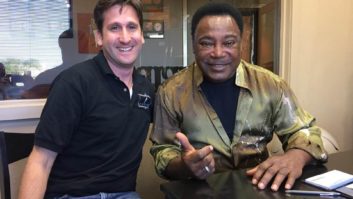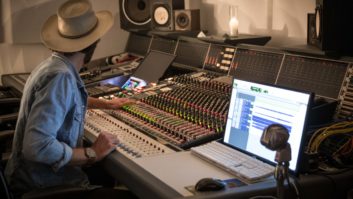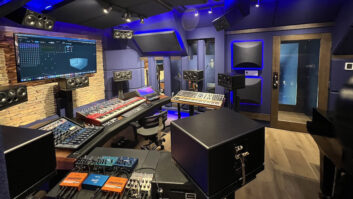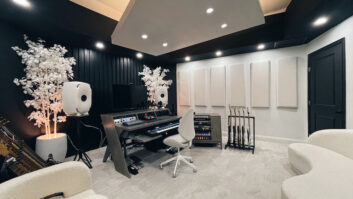The story of NightBird Recording Studios is just about as rock and roll as it gets: Producer/writer Jed Leiber was collaborating with legendary guitarist Jeff Beck in a guest room at the Sunset Marquis Hotel. Complaints about the ensuing noise prompted the hotel’s manager to offer the pair a basement laundry room to continue working. And with that move to the basement, Jed—the future founder and owner of NightBird—had a ‘eureka!’ moment, envisioning the appeal of a world-class underground recording studio on the premises of this Mediterranean villa-style hotel beloved by musicians and artists of all kinds.

“I think, first and foremost, we have the advantage of being one of the very few ‘destination’ studios left in the world,” explains Leiber. “We are tucked away, but perfectly located just off of Sunset Plaza in the heart of West Hollywood. Our clients certainly enjoy the benefits of that relationship. Aside from what you would normally find in a state-of-the-art recording studio, our clients enjoy 24-hour room service, a high-renowned restaurant, three bars, two pools and hotel suites ranging from single suites to a luxurious Presidential Villa. So basically, the hotel serves as our studio’s ‘lounge.’ The hotel’s accommodations especially come into play when we have clients from out of town and, with the many musicians that frequent the Sunset Marquis already, we often get the call from hotel guests that want to shoot down to the studio after their dinner to start up a writing session or perhaps to work on a mix from their show at the Hollywood Bowl that night. We have some of the best engineers and assistant engineers in the business, and we make every effort to ensure our clients are well taken care of, with privacy and security guaranteed.”
NightBird took flight after the construction of Studio A in 1992, followed by Studio B in 2003 and a complete renovation of Studio A in 2007. Besides updated aesthetic details, Studio A gained a 7.1 surround sound monitoring system, large LCD screens and a 110-inch projection screen and HD projector, broadening the room’s appeal to filmmakers, too.

“NightBird’s various rooms have grown organically over the years as demand increased,” offers Angelo Caputo, studio manager and director of technology for NightBird. “We’ve built out several new rooms over the last few years alone to accommodate some of the long-term writing sessions that have been more common recently. Studio A was the first studio built in the early ’90s—originally called The Studio at The Sunset Marquis—and was home to some of the best artists, writers and producers of the time. [Leiber] originally planned to build out a studio for his busy work schedule, producing and writing for Jeff Beck, John Oates, Cyndi Lauper, and composing for film and TV. He employed the architectural and acoustical expertise of George Augsperger, and made sure the studio space sounded as good, if not better, than some of the best rooms he had worked in in the past.”
“As demand for the studio grew, Jed added Studio B just down the hall, and continued to develop the facilities to keep on the cutting edge of music technology,” continues Caputo. “Both Studio A and B feature a large control room space, with a digital console—first a Euphonix, then a Digidesign D-Control & D-Command—and a smaller recording room. Larger than a traditional ‘vocal booth,’ each recording room was more than enough space to set up another production space, and even house a Yamaha 9-foot Concert Collection Grand Piano.”

“West Hollywood continues to be a mecca for creative people and, as such, we’ve become a kind of ‘center’ for musicians and filmmakers alike,” adds Leiber. “Not only have we had some of the best musicians and music producers in the business come through our studio, but we’ve also enjoyed the company of directors, producers, actors and editors, as we have a great film screening setup in our Studio A. There really is nothing like being able to have a meeting at the Cavatina restaurant, take a quick elevator down to a great recording studio and screen a film with the production team. In addition, there are many great writers and producers that live very close by, and they’ve made NightBird their home away from home, taking advantage of our facilities and highly knowledgeable staff.”
Added in 2013, Studio C was built to accommodate American Idol. “[The] production team took over the studios for several months each year to record and produce the music for the top-ten contestants of each season of the show,” explains Caputo. “Studio C is a production room/lounge combination that provides a great space for writers and producers to work with a unique space that is conducive to creativity. As we look into the future, we plan to develop more spaces nearby, and plan to built out a rehearsal space, a multipurpose filming space, and even some more production rooms/editing bays, as we’ve had some more demand for that recently as well.”

Gear-wise, NightBird was equipped for maximum flexibility, with Avid ICON rigs in both studios A and B. “Each engineer and producer has their own method of working, and having a desk that is flexible enough to accommodate nearly every workflow is very important to allowing creativity to take a front seat to technical know-how,” reasons Caputo. “We’ve seen instances where the ability of an engineer to find their way around the console can make or break a session, and we wanted to make sure the studios were outfitted in a way where nearly anyone with a working knowledge of Pro Tools and audio signal flow can find their way around the room and gear. We stuck with control surfaces for consoles, and concentrated on getting the best outboard gear possible to give us the flavors and sounds that the artists and producers wanted and needed. Jed, as a piano/keyboard player, amassed a collection of synths and keyboards that allow us to pull up just about any sound, and there certainly are some gems in [our equipment] list that you won’t find elsewhere.”
“We have the advantage of being one of the very few ‘destination’ studios left in the world…. Basically, the hotel serves as our studio’s ‘lounge.’”
—Jed Leiber, NightBird Recording Studios
For monitoring, Studio A has used Tannoy DMT System 215 main monitors from the beginning. “We have [Yamaha’s] classic NS10s in each of our studios as well,” notes Caputo.
Meanwhile, Studio B’s main monitors were recently upgraded to ATC’s SCM150ASL Pro enclosures, paired with dual Subwoofer Pros 18-inch subwoofers. “We’ve been ecstatic with their performance and reputation so far,” continues Caputo. “We’ve had a lot of great feedback in all rooms, and we’re especially proud of the fact that George Augsperger’s touch, along with Jed’s ear, has kept these rooms sounding as accurate and as fresh as possible throughout the years.”
NightBird Recording Studios • nightbirdrecordingstudios.com




